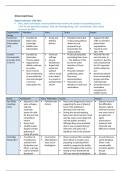Other
‘Britain in Depth’ Notes (Protest, Agitation and Parliamentary Reform)
- Institution
- PEARSON (PEARSON)
A comprehensive assortment of notes for the ‘Britain in Depth’ aspect of ‘Britain: Protest, Agitation and Parliamentary Reform’ for your Pearson Edexcel A-Level History exams! Covers: members, aims, tactics and impacts of the Society for Constitutional Information and London Corresponding ...
[Show more]



